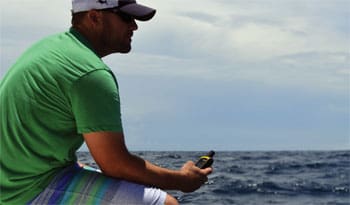Voyagers venturing beyond the reach of cellular transmissions used to have only two communications tools at their disposal: HF SSB radio and satellite phones. Technology has now advanced, however, to the point where text messaging is a more affordable and sometimes preferred alternative, providing long-range capability and flexibility.
Many of the benefits of satellite-based texting were on display during the Bermuda Challenge in August. The team of Chris Fertig and Tyson Garvin made the 780-mile run from New York Harbor to Bermuda in 15 hours and 48 minutes, setting a new powerboat record despite having to stop twice to repair broken propellers. Along for the ride was the handheld DeLorme inReach SE, which allowed Fertig and Garvin to communicate with land-based support personnel and receive weather updates.
While inReach cannot receive automated forecast information, the two racers were able to stay abreast of the conditions via two-way texting once they were outside of cell range. “This information was critical as it allowed us to know the conditions that lay ahead and helped us determine the best speed to travel,” Fertig said.
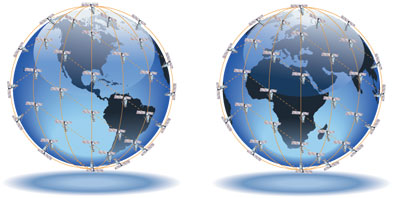 |
|
Courtesy Iridium |
|
The Iridium satellite constellation of low earth orbit satellites can relay signals if no earth station is in view. |
Garvin said the duo had a satphone with them, but texting proved to be easier and more effective from the cockpit of their 39-foot Skater 399. The boat has twin 480-hp Cummins diesels and a top speed of 84 mph.
“In an open-canopy speedboat, it gets pretty noisy,” Garvin said. “With a satphone you would have to stop to make a call, and obviously we didn’t want to have to stop. We could text as we were going.”
Touch-screen version
The inReach SE, introduced in 2011, is a touch-screen version of the company’s original inReach model. Both devices utilize the Iridium global satellite network and pair wirelessly with iOS and Android products through DeLorme’s Earthmate app. When voyaging in areas beyond cell coverage, boaters can use their smartphone or tablet to access topographic maps and NOAA charts downloaded before their departure. Real-time GPS location and tracking information can be overlaid on the digital maps to assist in navigation.
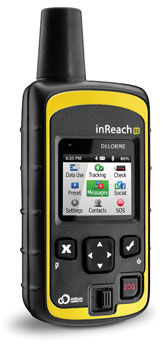 |
|
Courtesy DeLorme |
|
The DeLorme inReach SE makes use of Iridium satellites. |
During the Bermuda Challenge, Fertig and Garvin used inReach SE’s tracking feature to transmit their boat’s coordinates at programmed intervals for family members and other interested parties on shore. In the event of an emergency, the device’s interactive SOS automatically triggers remote tracking and allows boaters to update their situation with a monitoring center so the appropriate resources can be deployed.
InReach SE provides free-form texting of up to 160 characters to any cellphone number, e-mail address or social media page, with low-latency data links — “less than 60-second delivery of messages end-to-end,” according to DeLorme. That proved useful as Fertig and Garvin were speeding toward Bermuda.
“I was running it through my iPhone, which already had my contact list entered into it, and you could text with it pretty quickly right from the list,” Garvin said. “It helped us a lot. If you didn’t have any problems you wouldn’t need it as much, but of course we had problems.”
Finding new propellers
Chief among those problems were two broken propellers, the first incident occurring about 70 miles into the race and the second at the 650-mile mark. The men had spare parts on board — each repair took about 30 minutes and forced them to be more conservative with their speed afterward — but text messaging came in handy when trying to locate new propellers for the return trip to New York.
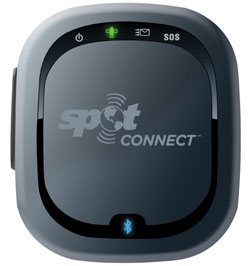 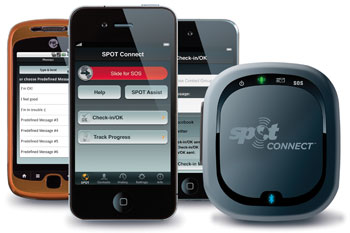 |
|
Courtesy Spot |
|
The Spot Connect unit, allied with a smartphone, provides text message sending capability in most of the world’s ocean areas using the Globalstar satellite network. |
“We texted back (to support personnel) to have them start to find us props to ship to Bermuda,” Garvin said. “I was able to write and give them people’s names and numbers to call from my contact list, about what they might have and might not have.”
Boaters experiencing more serious problems can use inReach’s SOS tracking to help search-and-rescue personnel pinpoint their location, with delivery confirmation if an alert is triggered. For those who encounter troubles that they are unwilling or unable to address — not everyone can handle repairing a propeller in the open ocean — texting can provide options that otherwise wouldn’t be available without taking on the cost of a satphone.
Kim Stiver, vice president of marketing for DeLorme, said many inReach customers find comfort in knowing that they can let loved ones know they’re okay anytime at sea, or that they might be running late. If they need help getting back into port, texting can be useful in determining the appropriate response.
“BoatUS encourages people to use text messaging for calling their tow service versus pushing an SOS,” Stiver said. “Getting a tow is certainly critical, but it certainly doesn’t warrant pushing an SOS and calling out the Coast Guard.”
In addition to two-way messaging and GPS tracking, Stiver said inReach’s cost has been a strong selling point. The suggested retail price for inReach SE is $299, with annual subscription plans starting at $120. Satphones range in price from about $500 to $1,300, although they also can be rented. Subscriptions typically start at about $600 a year.
“We’ve had quite a few customers tell us, particularly boaters in Florida who say they go frequently to the Caribbean, that they’re switching to an inReach device because voice isn’t really that necessary, and that they don’t want to pay the fees for satphones or the roaming charges for cellphones,” she said. “Where there is cell coverage, say, in the Bahamas, they’re charged such a high fee for it that they’d rather just send text messages. InReach is a more economical choice for them.”
For boaters interested in satellite text messaging at a lower price point, Spot LLC offers the Gen 3 ($169.95), Connect ($169.99) and Satellite GPS Messenger ($119.99). Spot Connect, a stand-alone unit designed to be used with iOS and Android smartphones by downloading a Spot app, has annual service plans starting at $99.
Globalstar system
The Spot devices offer many of the same features of inReach, including GPS tracking, SOS mode and social media access. But text messages can only be sent, not received, and Spot operates on the Globalstar satellite network instead of Iridium. Iridium’s technology allows messages to be relayed between satellites, providing coverage anywhere in the world. Globalstar relies on “gateway” stations on land to retransmit signals, which leaves remote expanses of the ocean without service.
Rich Galasso, distribution manager for Globalstar and its Spot subsidiary, downplayed the coverage “gap” because the Globalstar network can reach the vast majority of product users. He said the fact that Globalstar owns its satellites translates into lower prices for Spot devices.
“If we get about 2,000 miles away from a gateway we can’t communicate, so we’re never going to cover the whole globe,” he said. “But it’s never been our interest, never been our market. We figure we’re going to cover 99 percent of the area where people live, work and play, and do it cheaper.”
Galasso said Globalstar eventually will increase its number of gateways to 30 or 35 from its current 27, adding expanded coverage soon off the coast of South Africa. But there are no plans to add two-way messaging for Spot products, because the company believes that doing so would bring the price too close to satphones.
“For us, it’s not worth building a product that kind of drops in between,” he said. “We didn’t see a real benefit even though we could make one tomorrow.”
While Spot devices aren’t equipped for two-way texting, Spot Connect allows users to type and send “live” texts of up to 41 characters while out of cell range. Up to 14 predefined messages also can be sent to recipients on the user’s contact list, providing information about delays at sea or telling loved ones that all is well.
Flexible way to ask for help
Like inReach, Spot devices allow boaters to call for a tow without sending an SOS. The Spot Assist option sends an alert and the boat’s coordinates directly to a BoatUS dispatch center; a text message can also be sent with more details about the boater’s situation. A BoatUS membership is required.
Galasso said Spot communicators are frequently compared to EPIRBs and PLBs because they can be used to summon help in emergencies. But since Spot devices feature text messaging, he said they are much more likely to be in use — and available — when trouble arises.
“There are hurdles to EPIRBs and PLBs — people don’t even want to buy them,” Galasso said. “Safety doesn’t sell. I’ve been in the marine business for 20 years and I know that. Some people don’t register them or even take them out of the box, or they don’t send them in every five years to maintain them. The selling point of the Spot technology and products is the fact that this is a communications device first and foremost. … It’s more likely to be with somebody when they have a problem.”
For more information about Spot products, go to www.findmespot.com. To learn more about inReach, go to www.inreachdelorme.com.

